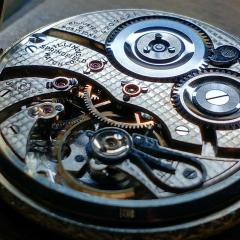-
Recently Browsing
- No registered users viewing this page.
-
Topics
-
Posts
-
Hi, My name is Simeon I am based in Sydney, Australia and have recently got into watch repair / watch making. I am very much a learner having serviced multiple forgotten watches, some of which were actually successful! I have a slowly growing collection of watches, mainly old Soviet, a few Japanese and (not pictured) some Raketas, a Poljot Alarm, an Omega Speedmaster Reduced and a vintage (1972) Tissot Seastar. I like unloved vintage watches, with quirky faces and enjoy bringing them back to life through the simple(!) act of disassembly, clearing and reassembly. I am an Electrical Engineer who also undertook a trade apprenticeship so I am reasonably handy - It's fair to say, I know just enough to get myself in trouble.
-
I took a chance on a non running Cosmotron X8 ("perhaps just needs a new battery" said the advert). Sure enough, I open it up and it has the wrong battery installed (a Renata 344 rather than the correct Renata 386) and the screws holding the battery contact had been sheared off to half a head on both ends. Ho ho, I thought - there's the problem. I got the broken screws out easily enough and as soon as I placed the correct battery in place the balance started. This picked up speed when I reinstalled one side of the battery contact and looked like it was a runner. As I was trying to get the replacement screws in, I did one side but the second was a bit of struggle (hold down the battery contact against its spring while dropping the screw in with tweezers) the balance stopped again. This time it wouldn't start again. 98 percent sure that I didn't stick anything, anywhere important or break it in a mechanical way. The battery was in place for most of the struggling with the contact, so it might have had an intermittent connection which could have upset the electronics. I tried giving it a puff with the blower but the balance doesn't seem to rotate in the normal way, it seems to be held in a static position by magnet. It can be pulled out of this position but spins back and stops dead. This may well be correct for all I know. Anyway, does anyone know anything about these watches and can tell me how I would go about and fault find this? I will be servicing it at some point so should be able to rule out mechanical issues from an old watch but not sure where to start with the electrical part of it.
-
By DonEilenberger · Posted
Sorry to reopen a necro-thread (long dormant) - I have a Seiko Kinetic 5M42A that needs at least one coil, possibly both. Anyone know of any sources? The usual fallback of eBay has failed me - there are people selling coils, but not the ones for this movement (which was apparently a very popular movement, used in Seiko and Pulsa branded watches.) The coil numbers are: 4002 516, and 4002 519 I'd also love to find a source for spares of the screws used all over this movement - they're Seiko PN 0022 247 Thanks! (Moderator - if this should be a new thread, please do feel free to tell me, or drag this one into a new thread.) Don Eilenberger








Recommended Posts